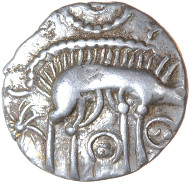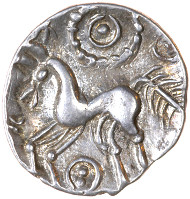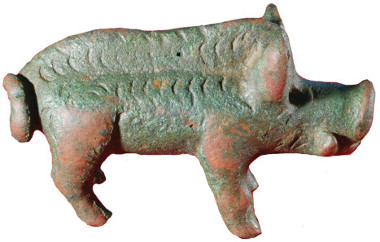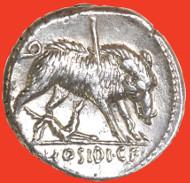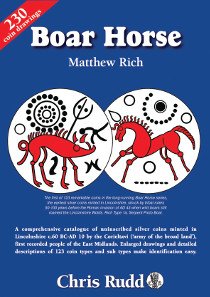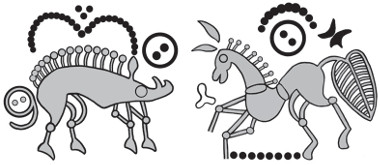by Chris Rudd
August 14, 2014 – Matthew Rich, 76, formerly chief financial officer of Reader’s Digest in Australia, has written a pioneering book, the first of its kind, and illustrated it with his own coin drawings. Called Boar Horse and published in August, it catalogues the earliest silver coins of the Corieltavi, a large Iron Age tribe of the East Midlands. Boar Horse tracks the development of the series which began around 60-50 BC and ended about AD 10. Nobody else has done this before.
Enlarged coin photos reveal remarkable details of Iron Age symbolism. Rich Type 10a, Two-Pellet Proto Boar. Source: Elizabeth Cottam, Chris Rudd.
Symbolising bravery in battle, the wild boar was probably a tribal emblem of the Corieltavi – an apt mascot for a tribe whose name means ‘army of the broad land’ or ‘army of [the goddess] Litavis’.
The Rothwell Boar bronze figurine, c.1st century BC/AD, found at Rothwell Top, near Caistor, Lincs., only 18 miles from where the famous boar-faced Witham Shield was dredged from the river Witham, near Lincoln, in 1826. Photo courtesy of Antony Lee, The Collection, Lincoln Museum.
Boars can not only be seen on Corieltavian coins, but also on a bronze shield, on a bronze war trumpet and as a bronze figurine which may have come from a helmet – all found in Lincolnshire, heartland of the Corieltavi.
Roman silver denarius of C. Hosidius Geta, 68 BC, prototype of Corieltavian boar horse coins. Source: Elizabeth Cottam, Chris Rudd.
Matthew Rich’s interest in coins was sparked by seeing Roman coins for sale while on a business trip to London in 1970. He assumed they were modern replicas and was astonished to discover that they were ancient originals. He first collected Roman coins, then Crusader coins and finally Ancient British coins.
“Superbly illustrated, the ideal handbook for collectors” says Dr John Sills of Lincolnshire, author of Gaulish and early British gold coinage (Spink 2003). Source: Elizabeth Cottam, Chris Rudd.
Dr Philip de Jersey, former keeper of the Celtic Coin Index, author of Celtic Coinage in Britain (Shire Archaeology 1996) and co-author of Ancient British Coins (Chris Rudd 2010), says: “Matthew Rich is to be congratulated for shining new light on the Boar Horse silver of the Corieltavi: one of the most beautiful, fascinating and complex coinages of the British Iron Age has finally received the attention it deserves. His clear diagrams will be particularly useful for all of us who have struggled to understand this complicated series.”
230 enlarged drawings make identification simple for finders, students and collectors. Rich Type 7a, Crown Proto Boar. Source: Matthew Rich.
Matthew Rich isn’t the first writer from Australia to take an interest in British culture. Others include Clive James, Germaine Greer and Barry Humphries. Boar Horse has 80 fact-packed pages, describes 123 coin types and sub types, indicates the rarity of each and contains 230 large-size coin drawings by the author, plus 37 other illustrations, all in colour. Published by Chris Rudd, £15 plus postage. ISBN 978-0-9566889-2-7.
If your are interested in Celtic coins and history don’t miss our archive section Celts.
To contact Chris Rudd or to learn more about him and his business go to his website.




